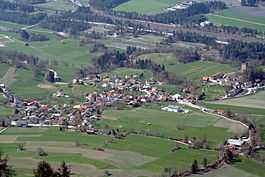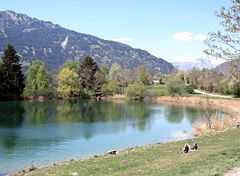Paspels
| Paspels | |
|---|---|
 | |
| Country | Switzerland |
| Canton | Graubünden |
| District | Hinterrhein |
| Coordinates | 46°44′N 9°26′E / 46.733°N 9.433°ECoordinates: 46°44′N 9°26′E / 46.733°N 9.433°E |
| Population | 468 (Dec 2012)[1] |
| - Density | 102 /km2 (264 /sq mi) |
| Area | 4.59 km2 (1.77 sq mi)[2] |
| Elevation | 778 m (2,552 ft) |
| Postal code | 7417 |
| SFOS number | 3634 |
| Surrounded by | Almens, Cazis, Rodels, Trans, Tumegl/Tomils |
| Website | www.paspels.ch SFSO statistics |
 Paspels | |
| Location of Paspels
 | |
Paspels (Romansh: Pasqual) is a municipality in the district of Hinterrhein in the Swiss canton of Graubünden.
History
Paspels is first mentioned in 1237 as in villa Pascuals though the original record no longer exists. In 1246 it was mentioned as de Pascuals.[3]
Geography

Paspels has an area, as of 2006, of 4.6 km2 (1.8 sq mi). Of this area, 33.3% is used for agricultural purposes, while 56.7% is forested. Of the rest of the land, 6.1% is settled (buildings or roads) and the remainder (3.9%) is non-productive (rivers, glaciers or mountains).[4]
The municipality is located in the Domleschg sub-district, of the Hinterrhein district. It consists of a linear village and a haufendorf (an irregular, unplanned and quite closely packed village, built around a central square) on a terrace above the Hinterrhine as well as the hamlets of Dusch and Canova.
Canovasee is a lake located in the municipality.
Demographics
Paspels has a population (as of 31 December 2012) of 468.[1] As of 2008, 3.1% of the population was made up of foreign nationals. Over the last 10 years the population has grown at a rate of 11.8%.
As of 2000, the gender distribution of the population was 47.4% male and 52.6% female.[5] The age distribution, as of 2000, in Paspels is; 72 people or 17.6% of the population are between 0 to 9 years old. 29 people or 7.1% are 10 to 14, and 19 people or 4.6% are 15 to 19. Of the adult population, 26 people or 6.4% of the population are between 20 to 29 years old. 65 people or 15.9% are 30 to 39, 70 people or 17.1% are 40 to 49, and 46 people or 11.2% are 50 to 59. The senior population distribution is 38 people or 9.3% of the population are between 60 to 69 years old, 26 people or 6.4% are 70 to 79, there are 16 people or 3.9% who are 80 to 89, and there are 2 people or 0.5% who are 90 to 99.[6]
In the 2007 federal election the most popular party was the SPS which received 39.7% of the vote. The next three most popular parties were the SVP (23%), the FDP (17.8%) and the CVP (15.7%).[4]
In Paspels about 81.5% of the population (between age 25-64) have completed either non-mandatory upper secondary education or additional higher education (either university or a Fachhochschule).[4]
Paspels has an unemployment rate of 0.6%. As of 2005, there were 18 people employed in the primary economic sector and about 6 businesses involved in this sector. 8 people are employed in the secondary sector and there are 3 businesses in this sector. 63 people are employed in the tertiary sector, with 14 businesses in this sector.[4]
The historical population is given in the following table:[3][5]
| year | population |
|---|---|
| 1808 | 245 |
| 1850 | 323 |
| 1900 | 302 |
| 1950 | 350 |
| 1960 | 286 |
| 1970 | 289 |
| 1980 | 318 |
| 1990 | 358 |
| 2000 | 409 |
Languages
Most of the population (as of 2000) speaks German (94.4%), with Romansh being second most common ( 3.7%) and Italian being third ( 1.0%).[4]
| Languages in Paspels | ||||||
| Languages | Census 1980 | Census 1990 | Census 2000 | |||
| Number | Percent | Number | Percent | Number | Percent | |
| German | 246 | 77.36% | 320 | 89.39% | 386 | 94.38% |
| Romanish | 63 | 19.81% | 31 | 8.66% | 15 | 3.67% |
| Italian | 3 | 0.94% | 3 | 0.84% | 4 | 0.98% |
| Population | 318 | 100% | 358 | 100% | 409 | 100% |
Heritage sites of national significance


The Church of S. Luregn/St. Lorenz and the Chapel of S. Maria-Magdalena in the hamlet of Dusch are listed as Swiss heritage sites of national significance.[7] The early medieval Church of S. Luregn/St. Lorenz was first mentioned in 1237. It was the parish church for the right side of the Hinterrhein valley. The Chapel of S. Maria-Magdalena was built in 1508 and was initially under the monastery of Churwalden. However, in the 16th Century, the hamlet of Dusch converted to the Reformation and therefore the chapel was also converted.[3]
References
- ↑ 1.0 1.1 Swiss Federal Statistics Office – STAT-TAB Ständige und Nichtständige Wohnbevölkerung nach Region, Geschlecht, Nationalität und Alter (German) accessed 16 September 2013
- ↑ Arealstatistik Standard - Gemeindedaten nach 4 Hauptbereichen
- ↑ 3.0 3.1 3.2 Paspels in German, French and Italian in the online Historical Dictionary of Switzerland.
- ↑ 4.0 4.1 4.2 4.3 4.4 Swiss Federal Statistical Office accessed 05-Oct-2009
- ↑ 5.0 5.1 Graubunden in Numbers (German) accessed 21 September 2009
- ↑ Graubunden Population Statistics (German) accessed 21 September 2009
- ↑ Swiss inventory of cultural property of national and regional significance 21.11.2008 version, (German) accessed 05-Oct-2009
| Wikimedia Commons has media related to Paspels. |
- This article incorporates information from the equivalent article on the German Wikipedia.